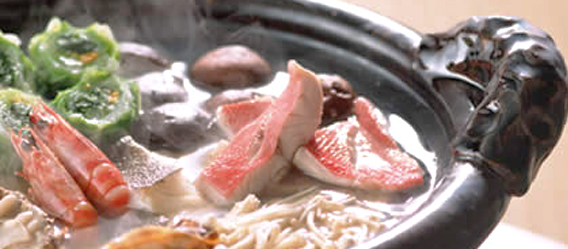 Nabemono can be translated into nabe, which means cooking pot, and mono, which mean all kinds of things. Nabemono, or sometimes referred to as nabe for short, is the name for a variety of Japanese hotpots. Popular during the cold winter months, nabemono is more than just a method of food preparation, it is also a way for friends and family to spend time in one another's company. In East Asia, hotpots are popular not only because of their tasty quality, but because it is believed that sitting around a pot and sharing the same pot in food preparation and enjoyment will strengthen relationships.
Preparing hotpots are easy and the rewards are great. It is a wonderful way to stay warm with friends and loved ones during cold months before the arrival of spring. Learn all about nabemono in this month's newsletter and try your hand at hosting your very own nabemono gathering.
Nabemono 101: The Basics
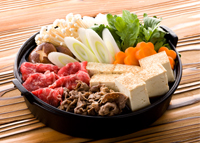 For those unfamiliar with nabemono and hotpots in general, the concept is simple. The idea is to set up a boiling hotpot in the middle of a table where friends and family gather around to cook ingredients in the same pot and enjoy these cooked ingredients in each other's company. For those unfamiliar with nabemono and hotpots in general, the concept is simple. The idea is to set up a boiling hotpot in the middle of a table where friends and family gather around to cook ingredients in the same pot and enjoy these cooked ingredients in each other's company.
In most contemporary Japanese families, nabemono is made possible by a portable electric stove that is set up in the middle of the dining table. Broth is used to flavor food and ingredients.
Uncooked ingredients are typically laid out on the table and guests can cook whatever they choose, and nabemono ingredients are generally enjoyed with broth or with a dipping sauce.
The Tools
Portable Electric Stoves are widely used in Japan for nabemono. These portable stoves can be powered by electricity or gas. Portable gas stoves for hotpots are also wildly popular in East Asia. The portable stoves' main purpose is to heat up the broth and ingredients in the hotpot, and main considerations when choosing a suitable portable stove is its size, functionality, ease of storage, and safety.
Portable stoves come in a variety of size, depending on the size of the party and dining table, you can choose a size that is most suited to your needs. Electric stoves as well as gas stoves each have their own advantages. Electric stoves are generally seen as the safer option, since the heat is powered by electricity, and many electric stoves today efficiently transfer heat without becoming hot, making it a preferred choice for families with small children.
Gas stoves on the other hand, boast of finer taste and bring broth to boil quicker than the electric stove. It is also easier to control heat on the gas stove. The downside is that portable gas stoves involve using butane or propane canisters and some may be concerned about the safety of using, as well as storing these flammable items. The reward, however, of using a gas stove, as claimed by proponents, is that the flavors obtainable from gas stove cooking still far exceeds that of the electric stove.
Hotpots
Choosing the ideal hotpot depends on suitable size and other 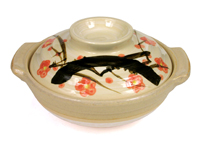 preferences. In general hotpots are traditionally made of clay (known as donabes), or with cast iron. Today, however, steel pots are also sometimes used. preferences. In general hotpots are traditionally made of clay (known as donabes), or with cast iron. Today, however, steel pots are also sometimes used.
Hotpots should come with a fitting lid for the purpose of bringing broth to a boil and for cooking of ingredients. Hotpots also typically feature a wider rim and a deep base. The wide rim ease the cooking of ingredients by guests around the table and the deep base allows supple room to contain the broth in which food is cooked.
Broth and Ingredients
The taste and flavor of the ingredients in hotpots are largely dependent on the broth that they were cooked in. As a result, the broth, or sometimes known as the soup base, in hotpots are extremely important.
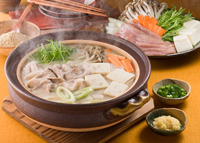 In Japan, there are two main types of nabemono - lightly flavored stock and strongly flavored stock. Lightly flavored stocks are mostly flavored by kombu - a type of edible kelp widely used in Japan and in East Asia - and are commonly enjoyed with dipping sauces. Strongly flavored stocks include miso, soy sauce and dashi flavored styles and are generally enjoyed without additional flavorings or dipping sauces. In Japan, there are two main types of nabemono - lightly flavored stock and strongly flavored stock. Lightly flavored stocks are mostly flavored by kombu - a type of edible kelp widely used in Japan and in East Asia - and are commonly enjoyed with dipping sauces. Strongly flavored stocks include miso, soy sauce and dashi flavored styles and are generally enjoyed without additional flavorings or dipping sauces.
In nabemono, the freshness of ingredients is vital as the taste and flavor of nabemono dishes are largely affected by the quality and freshness of the ingredient cooked in soup base.
Some popular varieties of nabemono include:
Yosenabe - one of the most popular nabemono in Japan. Yose means "putting together" and the concept of yosenabe is as its name suggests, it includes a mixture of various ingredients, including eggs, meat, seafood, vegetables, and tofu, and is usually cooked in a broth of miso and soy sauce.
Chankonabe - typically eaten by Sumo 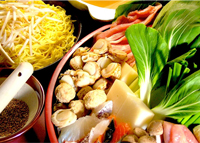 wrestlers to help them put on weight, and is usually cooked in dashi or chicken broth soup base with sake or mirin added for additional flavors. Chankonabe are typically protein rich and would include chicken, fish, meatball, tofu, eggs, vegetables, and sometimes udon noodles. wrestlers to help them put on weight, and is usually cooked in dashi or chicken broth soup base with sake or mirin added for additional flavors. Chankonabe are typically protein rich and would include chicken, fish, meatball, tofu, eggs, vegetables, and sometimes udon noodles.
Sukiyaki - often used to refer to thinly slices of beef. But in actuality, the name Sukiyaki refers to the nabemono dishes that uses fresh thinly sliced beef as one of the main ingredients along with tofu, mushrooms, vegetables and buckwheat or udon or shirataki ( a transparent type of noodle with a smooth almost jelly-like texture). The broth is made from soy sauce, sugar, sake and mirin and cooked ingredients are often dipped in egg yolk before being consumed.
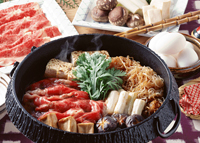 Shabu-shabu - another commonly heard name, and like the sukiyaki, employs thinly sliced beef. The name shabu-shabu comes from the swishing sound made during cooking. Like the sukiyaki dish, shabu-shabu dish is also commonly enjoyed with dipping sauces. Today, many shabu-shabu dishes contain chicken, pork, crab, prawn, or lobster as meat substitutes for the traditional beef, and are served with tofu, mushroom, leafy vegetables, seaweed, onions, carrots and buckwheat or udon noodles. While sukiyaki is considered sweet, shabu-shabu is considered savory. Shabu-shabu - another commonly heard name, and like the sukiyaki, employs thinly sliced beef. The name shabu-shabu comes from the swishing sound made during cooking. Like the sukiyaki dish, shabu-shabu dish is also commonly enjoyed with dipping sauces. Today, many shabu-shabu dishes contain chicken, pork, crab, prawn, or lobster as meat substitutes for the traditional beef, and are served with tofu, mushroom, leafy vegetables, seaweed, onions, carrots and buckwheat or udon noodles. While sukiyaki is considered sweet, shabu-shabu is considered savory.
Motsunabe - originating in the Fukuoka prefecture in Southern part of Japan, this unique nabemono dish uses beef or pork offal as its main ingredient. The offal, commonly intestine, is first boiled for a short amount of time, cabbage and garlic chives are then added. The broth is often made from soy sauce, garlic and chili peppers or, conversely with miso.
Secret Nabemono Ingredients
While the ingredients used to prepare nabemono dishes may be familiar to those already well acquainted with Japan cuisine, for many who are new to Japanese cuisine, they may be strange and exciting. This next section will introduce some of the basic ingredients from the previous sections.
Getting your hotpot dish just right needs no secret ingredients, just a willingness to get to know some of the commonly used ingredients, a bit of research, and then some hands on experimentation with friends and family around a steaming hotpot.
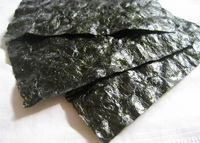 Nori - edible seaweed that are widely used in Japanese cuisine. Typical nori have been pressed, toasted and salted to achieve its paper-thin crunchy and savory quality. They are also used in sushi preparation. Nori - edible seaweed that are widely used in Japanese cuisine. Typical nori have been pressed, toasted and salted to achieve its paper-thin crunchy and savory quality. They are also used in sushi preparation.
Mirin - a type of alcohol very similar to sake, but with a lower alcohol content that is used primarily for Japanese cooking. It has a sweet taste and is used in the production of teriyaki sauces.
 Miso - a traditional Japanese seasoning produced by fermenting rice, barley and soybeans with salt and fungus. It is a thick paste with a savory, sweet, and earthy taste. It is commonly made into miso soup that is commonly served in Japanese cuisine. Miso - a traditional Japanese seasoning produced by fermenting rice, barley and soybeans with salt and fungus. It is a thick paste with a savory, sweet, and earthy taste. It is commonly made into miso soup that is commonly served in Japanese cuisine.
Mushroom - There are two popular kinds of mushrooms used in nabemono dishes, they are: Enoki/Enokitake and Shitake mushrooms. Enoki mushrooms are thin long white mushrooms with a light crunchy texture and a delicate taste. Shitake mushrooms are considered delicacies and medicinal food items in Japan. They feature a rounded brown cap and white stem, they have a springy texture and a light and fresh flavor.
Soba noodles - the Japanese name for buckwheat noodle. 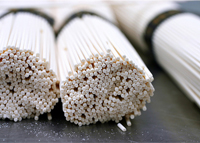 Often eaten chilled in a dipping sauce or in a hot broth, it is also popularly used in nabemono dishes. Often eaten chilled in a dipping sauce or in a hot broth, it is also popularly used in nabemono dishes.
Udon noodles - a thick wheat flour noodle with a springy texture popularly enjoyed with hot broth. Udon noodles are also sometimes served chilled in dipping sauces or stir-fried.
Before the arrival spring, when the sun will shine once more, for these last winter months, you can gather a few friends, grab a good hotpot and generate warmth, good food, and have a great time with simple nabemono recipes.
|